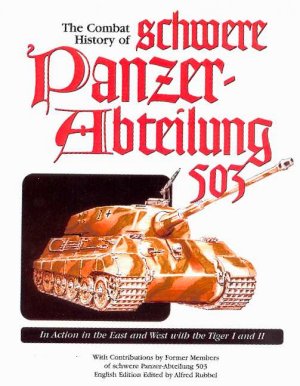

The Combat History of schwere Panzer-Abteilung 503
In Action in the East and West with the Tiger I and II
Andrew Dextras

This latest title from JJ Fedorowicz
Publishing is printed in the usual JJF large format 9” x 12” and comprises
392 pages. There are approximately
300 photos, the majority of which are unpublished.
Most of the photos are full page or half page size.
The book itself is a unit history written from the viewpoint of the unit members. Unlike many unit histories, which are written by third parties who summarize a unit’s activities, this book is a compilation of the unit’s actions described by the unit members themselves. The text was prepared by 3 former members of sPzAbt 503 and was assembled from recollections of a number of former unit members.
The tone of the book is set immediately from the start when Alfred Rubbel states that that “some peripheral occurrences related to the battalion’s existence may not have been known”. What Herr Rubbel is trying to say is that what may seem obvious to historians 50 years later might not have been something that a tank commander in sPzAbt 503 would be conscious of. Therefore, these memoirs can only be taken for what they are - recollections from former members of a Tiger tank battalion. This frankness is a refreshing change from the tone taken by many unit histories, which expect the reader to accept their word as gospel, regardless how many errors can be found in the text.
The writing style is interesting and not dry at all. The exploits of the unit members range from knocking out T34s in large quantities to flattening a house on a dare during a night of “festivities” to trying to avoid surrendering to the Russians at war’s end. I found the text very easy to ready.
As stated, the photographs are usually full page or ½ page. The photos are generally of very good quality but some of them have been seen elsewhere reproduced a little sharper. A few of the photos are a little bit light as well, however the majority of these photos are taken from veterans’ collections and not from a negative in an archive so it is unrealistic to expect the same level of crispness. This is a minor gripe and is certainly offset by the large number of unpublished photos which include some fantastic shots of Tiger Is and IIs in action, during maintenance and in more “relaxed” situations.
In summary, if you are looking for a picture book crammed with 600 images of Tigers, you’re best served purchasing Tigers in Combat I or II. However, if you’re looking for an interesting read from in a first person viewpoint written by the men who served in this successful Tiger unit, then you will find this to be an enjoyable book.
| Main | What's New | Articles | Reviews | Gallery | Think Tank | Contests |